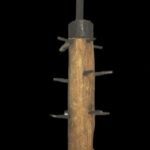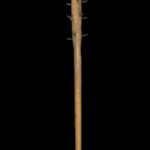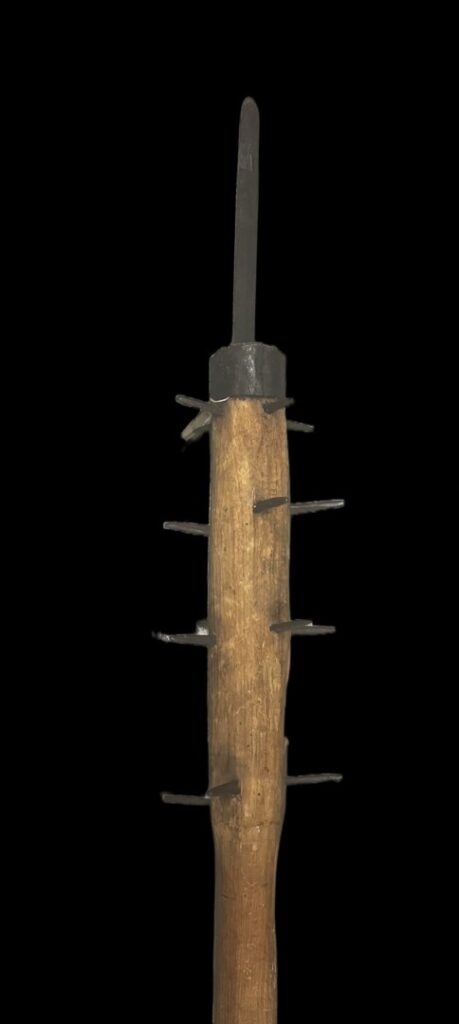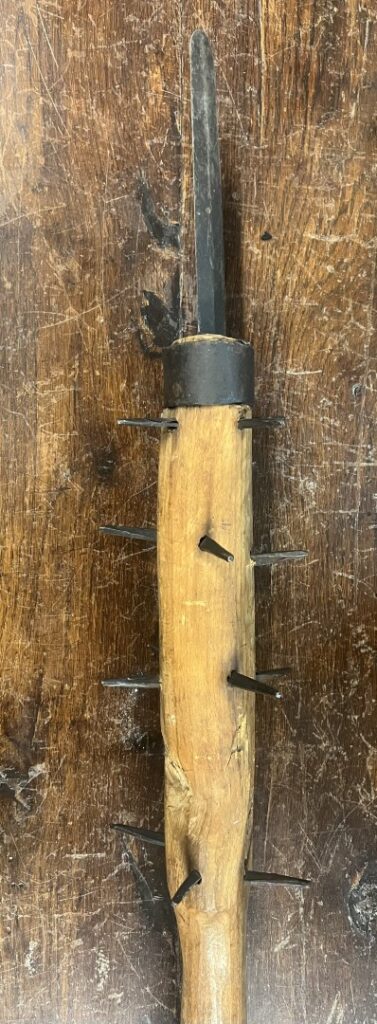1710) EXCEPTIONAL CONDITION MORNING STAR STAFF WEAPON FROM A GERMAN NOBELS COLLECTION: No weapon gets more attention from people viewing a collection than a Morningstar. Museum tag 16th-17th century. Priced to sell immediately under $1,250 with free shipping.
Introduction: This example is the epitome of this typology of weapon, in superb condition, and it comes from a Nobles armory. In other words, it has everything going for it. The Morningstar (Morgenstern) was used in Europe for over 500 years, and the construction did not change. Therefore, it’s difficult to date accurately. This example most likely is from 1550 to as late as 1700.
Discussion: To this day, armorys throughout Europe still have Morningstar staffs. Why such a long time? Because it’s a highly effective weapon with multi-use that the village blacksmith could easily and inexpensively make. You could learn how to use it in a very short period of time. It was not a Knightly weapon; instead, it was used by militias, peasants, and man-at-arms who had to equip themselves and could not afford expensive Knightly weapons or the time to learn how to use them.
A variant of the Morningstar, the “goedendag” (see page 46 in my book), was instrumental in the defeat of the French Knights during the Battle of Courtrai (Golden Spur). The citizens of Flanders rebelled against the annexing French army of King Philip IV and stormed the French garrison at Courtrai castle. The French responded by sending a highly-trained military force consisting of 2,500 mounted knights (noblemen) and 5,500 heavily armed infantry under the command of Robert of Artois. The mounted knight was the doomsday weapon of its day. The Flemish responded with a mere 400 mounted knights and 8,600 untrained Flemish militia, most of whom were members of the local weavers’ guild. On the surface, this looks like an easy victory for the French. However, the French victory quickly became more like David and Goliath. What was the Flemish 3-part secret to victory?
(A) The Flemish dug deep ditches in marshy terrain surrounded by streams and moats, neutralizing the cavalry charge. The unfortunate knight who made it through the knee-high mud would soon be met with a (B) wall of pikes (long-hafted spears). The charging French knights (many of whom were dismounted) were quickly and easily killed. (C) The Flemish had an inexpensive weapons innovation that was easy to mass-produce and master without years of training. The goedendag is a long, heavy club with spikes and a spear tip similar in concept and design to the Morningstar. Wave after wave of charging French infantry met the same outcome.
Description: Constructed from a long, thick wooden haft, the spherical head bristling with a series of diamond-shaped embedded steel point spikes with a long triangular spike at the top, tapering to a sharp point. The head is held in place with a ferrel at the top and bottom of the head. It has a beautiful deep chocolate brown patina throughout. The haft shows the wear and separation you would expect from such an old wooden weapon. Approximate Length: 68 inches.
Provenance: From the armory of a German Nobles’ collection
Conclusion: A great and inexpensive addition to any collection at under $1.250!!!.
This is a time capsule of Renaissance military history !!!*
All my items come with the following:
–Free shipping.
–10-day review period.
–Certificate of Authenticity.
– Free autographed copy of my book if you do not have one.
I believe you will be very….very…. pleased. ACT NOW!!!!*
Contact Me To Get The Latest Lowest Price Possible From The Owner Under $1,250*








